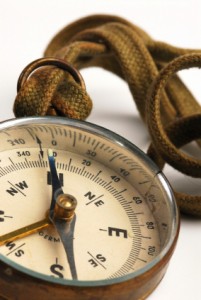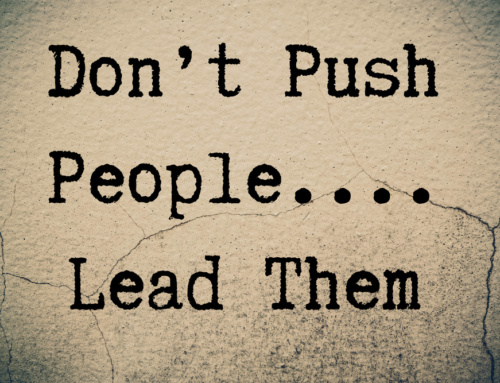 For many leaders, circumstances have an annoying habit of drawing our attention off of what we should be focusing on towards something more immediate or more novel. For anyone leading a team, this loss of focus (or loss of edge) is what I describe as “Leadership Drift.”
For many leaders, circumstances have an annoying habit of drawing our attention off of what we should be focusing on towards something more immediate or more novel. For anyone leading a team, this loss of focus (or loss of edge) is what I describe as “Leadership Drift.”
Drift too far from your core leadership tasks and you and your team will end up somewhere other than the your targeted destination.
4 All-Too Common Contributors to Leadership Drift:
1. Comfort. From growing comfortable with your team’s performance to simply growing comfortable with your team members, once you’ve developed familiarity it’s easy to rationalize backing off of the intensity level just a bit.
One manager offered that as time and trust grew with his team members, he quit doing some of the things that encouraged them towards high performance. “In particular, I now know that our performance slip started when I quit asking the hard questions. I mistakenly assumed the teams would do this on their own with the same level of intensity I had historically applied.”
2. The Distractions of Success and Responsibility Growth. Good managers are typically rewarded with added responsibilities, and the resultant tasks often bring with them a high level of overhead and administrivia that have little to do with promoting team performance and personal development.
Once the balance of your time moves away from coaching, delivering feedback, supporting decision-making and reinforcing the pursuit of core goals and strategies, people and teams begin to drift off-course. A little drift now potentially leads to big misses down the road.
3. Altitude Issues. Operate too long on the forest floor or, too high above the tree line and you’ll promote different forms of drift. The detail-obsessed leader drives the focus of her team towards the minutiae and it becomes easy to lose track of direction and progress. The “Big Picture” only leader is often talking in terms and pictures that others can’t directly connect to their daily challenges, resulting in a loss of focus and intensity.
4. Boredom…Yours. I’ve known more than a few leaders who have grown bored with their daily tasks and have allowed themselves to drift off-course in pursuit of something more intellectually stimulating in the workplace. While this can set-in at any level, it’s particularly common for mid-career professionals who have grown fatigued from their work-a-day routines.
6 Helpful Reminders to Prevent Leadership Drift:
1. Use Intensity for Good Instead of Evil. If you’ve cultivated a high quality, high performance team, your intensity and your focus on performance are some of the reasons people are there working with you. High performers respect positive intensity and they expect to be challenged. They appreciate tough questions and they enjoy the challenge of thinking through and around issues in pursuit of innovative solutions. They don’t want nor need for you to back off of the behaviors that push them forward.
 2. Intensity, Part 2. Create opportunities for teams to reset, recharge and generally refresh. Your team members aren’t automatons. The best leaders monitor and help regulate the energy and intensity levels of their teams, and allow ample time for refueling. And don’t forget to allow ample time for your own refueling or you introduce boredom into your daily work life.
2. Intensity, Part 2. Create opportunities for teams to reset, recharge and generally refresh. Your team members aren’t automatons. The best leaders monitor and help regulate the energy and intensity levels of their teams, and allow ample time for refueling. And don’t forget to allow ample time for your own refueling or you introduce boredom into your daily work life.
3. Less Telling, More Teaching. As your team matures, it’s appropriate for you to shift from tell to teach. Instead of backing off, shift the nature of your discussions. Ask questions and encourage people to share their ideas, approaches and insights. Resist the urge to allow your perspectives to overwhelm theirs.
4. Help Your Team Acclimate to Frequent Altitude Adjustments. It’s essential that you help your team members connect their projects and activities to your firm’s goals and strategies. You of all people must help people see clearly from the forest floor to slightly above the tree line and even over the horizon. Create forums that transcend the typical status and operating meetings to explore higher-altitude topics and always strive to conclude them with the team forming answers to: “What does this mean to us in our daily activities?”
5. Learn to Recognize the Issues that Promote Drift for Your Team Members. Everyone is capable of being distracted. From excessive preoccupation with status meetings to preoccupying on the wrong issues to becoming trapped in the Outlook calendar, it’s essential that you learn to recognize and help people overcome performance drift.
6. Don’t Lose Sight of the Core Ingredients of Focus: clear expectations, accountability and feedback.
The Bottom-Line for Now:
There’s a “one in sixty” rule often referenced in navigation. For every one degree you are off in your direction, you will be off approximately by one mile for every 60 miles you travel. Can you afford this much drift on your team?
—
More Professional Development Reads from Art Petty:
Don’t miss the next Leadership Caffeine-Newsletter! Register here
For more ideas on professional development-one sound bite at a time, check out Art’s latest book: Leadership Caffeine-Ideas to Energize Your Professional Development.
New to leading or responsible for first time leader’s on your team? Subscribe to Art’s New Leader’s e-News.
 An ideal book for anyone starting out in leadership: Practical Lessons in Leadership by Art Petty and Rich Petro.
An ideal book for anyone starting out in leadership: Practical Lessons in Leadership by Art Petty and Rich Petro.






Leave A Comment